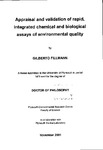Appraisal and validation of rapid, integrated chemical and biological assays of environmental quality
| dc.contributor.author | FILLMANN, GILBERTO | |
| dc.contributor.other | Faculty of Science and Engineering | en_US |
| dc.date.accessioned | 2013-09-16T12:54:24Z | |
| dc.date.available | 2013-09-16T12:54:24Z | |
| dc.date.issued | 2001 | |
| dc.identifier | NOT AVAILABLE | en_US |
| dc.identifier.uri | http://hdl.handle.net/10026.1/1767 | |
| dc.description | Merged with duplicate record 10026.1/2372 on 13.20.2017 by CS (TIS) | |
| dc.description.abstract |
To assess the significance of pollutants released into the environment it is necessary to determine both the extent of contamination and the biological effects they give rise to. This research is based on a tiered system, which commences with conventional analytical chemistry (gas chromatography), followed by the development, evaluation and application of rapid and simple immunochemical techniques and, finally, the integration of chemical and biological markers to assess pollution. GC-ECD/FID/MS have been used to investigate the status of chemical contamination of the Black Sea by organochlorine residues, hydrocarbons and faecal sterols. Useful information is provided and problems with e.g. HCHs and sewage contamination are highlighted. Contamination by DDTs, PCBs, "total" hydrocarbons and PAHs is also reported. Next, these techniques are used to develop rapid screening methods. Four distinct applications of immunochemical techniques are presented. Initially, the BTEX RaPDD Assay® ELISA is evaluated to detect semi-volatile hydrocarbons in contaminated groundwater. Although overestimating concentrations when compared to GC-FID/PID, results are well correlated. Secondly, the effectiveness o f the BTEX and c-PAH RaPID Assay® to detect hydrocarbons in sediments is tested. Once again, good agreement with GC-FID/MS confirms the ELISA to be a useful screening protocol to focus more expensive high-resolution analytical techniques. The adaptability and applicability of an ELISA (PCB RaPID Assay®) method in measuring "total" PCB levels in mussel tissue is demonstrated. An underestimation of concentrations, despite of covariability between ELISA and cGC-ECD, is discussed. Next, ELISA (RaPID Assay®) and fluorometry were successfully applied to quantify PAH metabolites in crab urine as a measure of exposure. HPLC analyses indicated that conjugate PAH metabolites were dominant in urine of crabs exposed to pyrene. Differences could also be identified between crabs taken from clean and contaminated sites. Finally, an integration of chemical and biological techniques is used to investigate contamination and effects in mussels within a pollution gradient. Results indicate a correlation between micronucleus formation, heart rate and PCB and PAH level. | en_US |
| dc.description.sponsorship | Plymouth Marine Laboratory | en_US |
| dc.language.iso | en | en_US |
| dc.publisher | University of Plymouth | en_US |
| dc.title | Appraisal and validation of rapid, integrated chemical and biological assays of environmental quality | en_US |
| dc.type | Thesis | |
| plymouth.version | Full version | en_US |
| dc.identifier.doi | http://dx.doi.org/10.24382/3249 |
Files in this item
This item appears in the following Collection(s)
-
01 Research Theses Main Collection
Research Theses Main


